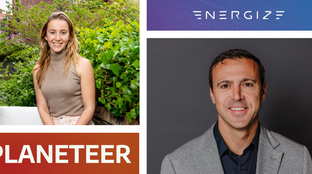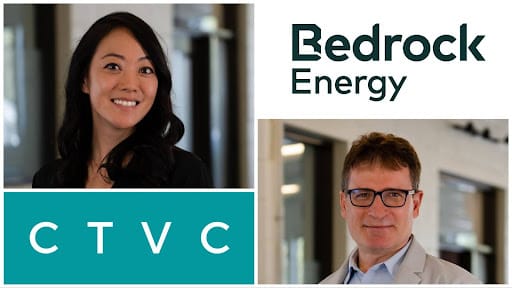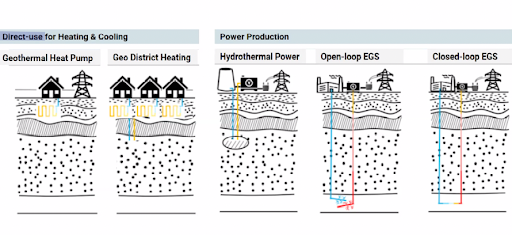
🌎 Two climate investors on raising in today's tough market
Q&As with Sophie Purdom, who just closed first-time Planeteer Fund I, and John Tough, who recently closed Energize Capital's mega-fund Ventures Fund III
The Goldilocks effect in geothermal HVAC systems

Geothermal energy is climate tech but it isn’t new tech.
Pulling heat from the subsurface of the earth has been a proven method for powering the cooling and heating of buildings for ~70 years. But the costs, implementation timelines, and space requirements have relegated this type of HVAC system to very large and fancy properties (think military bases, presidential libraries, and museums).
Bedrock Energy, which just announced a $8.5M seed round this week, aims to bring this all-electric, energy-cost-saving tech to commercial and industrial properties by re-engineering the tools of oil and gas to drill deeper, faster, and cheaper.

We sat down with Co-founder and CEO Joselyn Lai to learn more about how Bedrock Energy aims to make geothermal more accessible, plans for this recent funding, and why the data is actually the most important piece in accelerating all-electric HVAC deployment.
Tell us about the founding story of Bedrock Energy. How did the team come together from all these different industries and how did you jump into pursuing this solution?
Joselyn: My co-founder, Silviu Livescu, spent nine years as chief scientist of pressure pumping at Baker Hughes, and before that he was at Exxon. So he has a very rich history and almost 40 patents in the O&G space. He realized that O&G technology can be reengineered and redesigned for geothermal direct-use heating and cooling for buildings. We met through investors and thought, ‘Alright, the technology can make geothermal happen. This sounds doable, but more importantly, all the tailwinds are right for net zero mandates on real estate properties, and for gas prices probably being structurally higher over the next 10 years and beyond.’ So many conditions are starting to be right to say that geothermal heating and cooling can be a really scalable asset class. There are a lot of people out there who are getting interested in geothermal heating and cooling as developers, but nobody's really in it saying, ‘let's actually bring in technology to make it scalable, and make the economics fundamentally better.’ So we got excited about that, and the team we've built has been pulled from O&G, but also from big tech and commercial real estate—trying to make it a really multidisciplinary team to solve this challenge in a uniquely rapid way.
Could you put into context the problem you’re trying to address and the scope of the climate impact that your technology is trying to solve for?
We're focused on the fact that building heating and cooling is an incredibly stubborn source of carbon emissions, and also a huge draw on power and a huge source of increasing power demand over time as the planet gets hotter. Geothermal heating and cooling is really well established as the most efficient way to do heating and cooling in buildings and it's all-electric. The reason there hasn't been more geothermal is because the subsurface borefield component is expensive and time-consuming and space-demanding to install. So that just takes it off the table for a lot of property owners, a lot of engineering firms, a lot of architects, who would otherwise say, ‘Holy cow, geothermal would be amazing for my net zero goals.’
You mentioned some of the challenges that have held back geothermal as a source of heating and cooling historically. Could you talk briefly about the innovations your team is working on that make the technology more feasible?
Historically, the key barriers have been one, it costs a lot of money. Places like military bases, embassies, museums, fancy libraries, have needed 20- to 30-year payback periods for these larger systems. Not doable for most real estate owners. The second thing is that people tend to drill pretty shallow—300 to 600 feet, maybe 800 feet if you're really pushing it—but if you drill that shallow you need a lot of space. You need a lot of bore holes, and most people don't have a football field or a campus quad in order to construct these systems. The third thing is if you need that many holes, it can take a long time. Some of the more prominent projects have needed maybe a year to do the drilling and construction of those bore fields. It pushes out everything else you need to do on construction—the foundation people and the other folks on the project are just twiddling their thumbs, and you are paying all these interest dollars on your cost of capital for a year. So those three things often will just take it off the table.
At Bedrock, we’ve built a drilling technology stack—software and hardware—that can drill deeper, faster, and with more confidence and precision, so that you don't have delays from errors and mistakes in the construction process. We have a drilling unit that can actually drill continuously—no stop-and-go, not very manual—all the way down to 2,000 feet. So for the same amount of load, we might be able to do a project in three or four months rather than a year, which can save eight or nine months on the cost of capital. And because we go through those depths, we don't need as many holes. We don't need as much space. And you can actually get geothermal in a relatively urban environment.
Is there anything else you would want to make sure our readers understand about the data you're collecting?
We see that no clean energy asset class can actually scale if you don't have data that makes this energy asset class really underwritable, credit-worthy. With solar, it wasn't just that solar panels got cheap. That was one piece. But in order to have PPAs at scale, in order for Goldman's sustainable finance arm or Apollo’s clean energy project finance arm or Generate Capital, for example, to put money into all these projects—that kind of capital doesn't come into any asset class without being able to say, ‘In this area, solar can produce at this level over this many years.’ And you can predict that, underwrite it, and then bring in finance. And only with financing can you do clean energy deployment broadly. With geothermal for the last 70 years, people understand the building side, but the subsurface side is honestly still very unknown. So the data we collect is about extremely precise characterizations of lots and lots of different data points about the soil and the rock throughout many, many feet—1,000 feet, 2000 feet deep. And characterizing all of the different bores and all of the different subsurface dynamics. That precision and that ability to model the physics of that energy transfer is essentially our contribution to making these geothermal bore fields a creditworthy, predictable, reliable asset class, so that you can eventually say, ‘Yes, I guarantee that it will perform like this over 30 or 50 years.’ And then that makes it worthy of capital coming in for financing and broad-scale deployment.
If you can’t predict that, geothermal is only going to happen for a rarefied segment of owners. It's kind of like all the software that now exists in the solar market. There's a whole ecosystem of startups that have come in and can just do aerial imagery and can say, across this entire community, which of the households have the right roof angle? Which of the households have the right tree cover? Which cities have the best cloud cover and solar patterns? That makes solar something that you can literally do in any city in the world at this point. We need that to happen for geothermal, where people will understand that this is the data that is gathered about the subsurface, and, at a really precise level, this is the system that is the most optimal that you can then finance.
Some other climate tech solutions are really new and people are unfamiliar. Considering that the narrative about it being unproven is not as much of an issue with geothermal, are there other major blockers you're facing as you start to scale? What are the other big challenges you see that you'll have to overcome?
We’ve definitely benefited a lot from the fact that we're not trying to reinvent something crazy. Geothermal heat pumps have been around. Some of the technologies we've developed have existed in this much more expensive, big, bulky infrastructure level scale for O&G. So it's a matter of building for an application, not building basic science or basic technology risks. So we certainly have to streamline operations and get good at delivering, but that's a different type of risk. We just need to get reps. We need to do projects and learn about different customers’ logistical processes to make it easy. That's probably the biggest thing—just about reps and experience and operational streamlining. Longer term, we certainly need to scale. We need to build not just one set of equipment and crew, like we have today, but we're going to need 10, 20, 30, 100. To do that we are working with experienced manufacturing partners to say, ‘How do we get our supply chain lined up to make lots and lots of these rigs?’ And we already have equipment financing partners who are able to see how our equipment is really valuable, and they can come in as capital partners for building lots and lots of rigs. So that's the scaling goal and the challenge we have in the next step.
Are there specific challenges that come with being both a hardware and a software startup?
There's something fascinating, but also beautiful, about saying, ‘Look, here's some hardware engineers that come from O&G, but also Apple. And then here's some software engineers that come from Silicon Valley. And they've never really worked with each other before.’ So there's a little bit of a cultural meshing that we're doing that requires understanding the backgrounds of all of these really diverse people and getting them to work together at the speed and at the pace that startups—especially venture-backed startups—need to do. So I think that's honestly something that a lot of climate tech companies have to do, just because we are building in the real world, and you have to bring those software people who go so fast together with hardware people who know the real-world ramifications of what they're building.
What has it been like trying to recruit talent from all these different areas? Are you finding that there are a lot of folks with O&G experience who want to jump into this field?
From the O&G industry, we have hired folks on the engineering side, technology engineering and field engineering, and folks from the field operations side—folks who are in the field operating the machinery. Between all of them, our team has probably millions of feet of hydrocarbon wellbore construction experience.
I think what's important to note is that the O&G industry is characterized by feast and famine. There are years where all prices are high, and they're hiring, hiring, hiring, and just so busy. And then there are years, like recently, during COVID, where energy prices plummeted, and people are laid off. And you will have PhDs who are working in fast food restaurants. You will have people who are often unable to find work in their profession for months and months and months at a time. I think people are tired of that, and the clean energy transition offers an opportunity, especially if your skill set is transferable from O&G into a category like geothermal, to have work in a changing economy. And not only is it the prospect of stability and future opportunity in a new world, but also, these are jobs that are domestic. You don't have to be in Saudi Arabia or the Middle East for three weeks on, and then come home for a week to be with your family. Or sometimes it's more like five weeks on, and you don't see your kids. You don't get to be with your family. What we love is the ability to say, ‘Yeah, we want to drill, but in suburban and urban areas, and you can live in the region that we staff your crew and your rig to. And you can go drill on normal construction hours and then come home and be with your kids for dinner. And be with your kids on weekends.’ So I think that's something that has been a really important message that we've had for the O&G industry.
Are there any other common misconceptions about geothermal that you want to dispel?
The high-level thing that we're trying to dispel is that geothermal has a long payback period and isn't suitable. We are actually here to say that geothermal is profitable. You can make money doing it. You save so much money that the IRR is ~15%, which makes it a legitimate thing to do, even if you don't care about the environment. But you can have that kind of return and that kind of financial benefit while also going Net Zero.
There are also some funny FAQs that ask things like, ‘What about earthquakes?’ And the nice thing about this kind of geothermal is that the boreholes are very, very narrow, and we're not fracking. In geothermal power production, oftentimes there's an element where you're fracking and you can have induced seismicity. In O&G, you're definitely fracking and inducing seismicity. This kind of geothermal is a narrow borehole and then you fill it right back up. After you put in the heat exchanger, which is just a plastic pipe—super stable—you literally fill it up again. You're not causing foundational or seismological instability. On the other hand, if you do have earthquakes come to you, these bores are so narrow, and they're honestly pretty flexible. So you're not going to damage your system because of earthquakes. It’s durable and so much safer than anything else that you would do.
Congratulations on your recent funding round! Can you tell us who's involved and what the goals for growing the company are with this capital?
Joselyn: We first raised a $6 million seed round, led by Wireframe Ventures. In less than a year from raising, we built this big drilling machine. There was a lot of excitement about where we were, so we actually had some inbound offers to invest before the Series A. So altogether, we are at $8.5M in overall seed funding. We’ll be using this funding to refine this technology, including the drilling, the subsurface data acquisition, and also the software for thermal reservoir performance simulation and modeling. The funding is also for supporting deployment in more projects and growing our team for all of these unique competencies and all the things that have to come together in a physical, hard-tech deployment.
Wireframe Ventures, which is a seed-stage climate tech and health tech VC that has good experience from even the first wave of clean tech, especially in the built environment. We also partner with Overture, which is a fund that has close ties with regulatory affairs, and a lot of the folks in their extended team are former DOE, so they're really knowledgeable about IRA implementation, federal and state level tailwinds related to technology demonstrations and deployments, and mandates for sustainable cities. Then we also have partners, like Cantos and Long Journey Ventures that are steeped in hard tech—folks who have been investing in the physical world and industrial technology for a long time. What's awesome is the combination of clean energy understanding and network, regulatory affairs, which is obviously so important in this moment, and also in the built environment and more traditional hard tech investing.
Eager to get drilling for that sweet, sweet subsurface heat energy? Bedrock is hiring!

Q&As with Sophie Purdom, who just closed first-time Planeteer Fund I, and John Tough, who recently closed Energize Capital's mega-fund Ventures Fund III

A Q&A with Precursor's David Yeh and Mark1's Julian Ryba-White, new strategic partners in the ecosystem

A Q&A with the DOE LPO director Jigar Shah and Solugen CEO Gaurab Chakrabarti